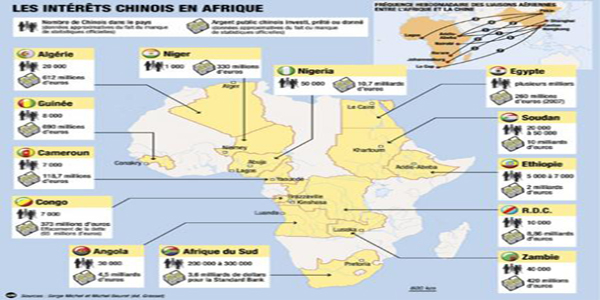- Washington “follows with interest” Morocco’s openness onto Africa (John Kerry)Posted 11 years ago
- The trial of South African Paralympic champion Oscar Pistorius opened in Pretoria on Monday.Posted 11 years ago
- USA welcomes efforts of King Mohammed VI in MaliPosted 11 years ago
- Egypt’s population reaches 94 millionPosted 11 years ago
- Mugabe celebrates his 90thPosted 11 years ago
- Moroccan Monarch to Build a Perinatal Clinic in BamakoPosted 11 years ago
- King Mohammed VI handed a donation of bovine semen for the benefit of Malian breeders.Posted 11 years ago
- Moroccan King’s strategic tour to Africa: Strengthening the will of pan African Solidarity and stimulating the south-south cooperation mechanisms over the continentPosted 12 years ago
- Senior al-Qaida leader killed in AlgeriaPosted 12 years ago
- Libya: The trial of former Prime Minister al-Baghdadi AliPosted 12 years ago
Africa/China: unbalanced trade or tremendous opportunity?
 The historical stage of 106 billion dollars of trade between China and Africa had been reached in 2008. In 2009 and due to the global crisis, it dropped to 91 billion. This year marks the resumption, and trade between the two partners has increased by 65% in the first semester and should reach the 2008 record. 2009 has been the only flat period in a long and steady increasing trend in trade between China and Africa. Almost nonexistent in 1956 with only 12 million dollars in business, trade reached 10 billion dollars in 2000.
The historical stage of 106 billion dollars of trade between China and Africa had been reached in 2008. In 2009 and due to the global crisis, it dropped to 91 billion. This year marks the resumption, and trade between the two partners has increased by 65% in the first semester and should reach the 2008 record. 2009 has been the only flat period in a long and steady increasing trend in trade between China and Africa. Almost nonexistent in 1956 with only 12 million dollars in business, trade reached 10 billion dollars in 2000.
Since then it has been increased tenfold with an increasing rate of 30% per year. In 2005, China surpassed Germany and become the leading supplier of the continent.
China’s rapidly growing demand for energy and natural resources has created increasingly important strategic partnerships with African nations. Blessed with a strong endowment of mineral fuels and ores, Sub-Saharan nations are benefitting from Chinese demand that has driven commodity prices up and generated billions in infrastructure investment on the continent. While some believe China’s entry into Africa is simply another neo-colonial effort with a clear disregard for human rights and the legitimacy of governments, many believe China’s pragmatic and businesslike approach is more dynamic and well rounded than classic Western aid efforts.
China is providing African nations with a tremendous opportunity and has made them relevant again to global policymakers, but it is up to Africa to capitalise and drive a hard bargain so that it finally comes out winning, even if trade remains imbalanced. China exports consumer goods and Africa provides energy and agricultural commodities. Mineral fuels such as oil were by far China’s largest import from Africa. Put together, mineral fuels, ores, precious stones and metals accounted for 87% of Chinese imports from Africa. As a result of this, the top five sources of African imports were Angola (40%), South Africa (15.5%), the Sudan (11%), the Congo (8.2%) and Libya (5.7%).
